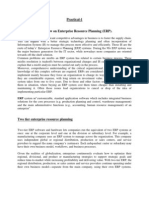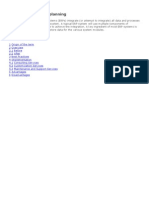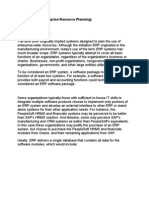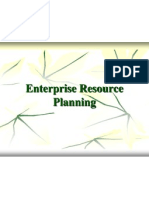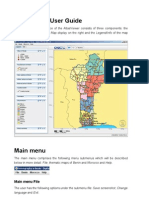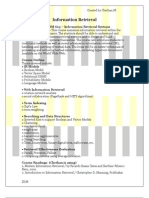ERP Software
ERP Software
Uploaded by
andreslomeCopyright:
Available Formats
ERP Software
ERP Software
Uploaded by
andreslomeOriginal Title
Copyright
Available Formats
Share this document
Did you find this document useful?
Is this content inappropriate?
Copyright:
Available Formats
ERP Software
ERP Software
Uploaded by
andreslomeCopyright:
Available Formats
Ministry of
Communications and
Information Technology
Information
Technology Institute
Mostafa Mahmoud Ibrahim
ITI, Software Engineering
free_noble@yahoo.com
Definition.
ERP Legacy.
ERPs elements and subsystems.
How can ERP system improve a business system?!
What does drive ERP approach?!
ERP implementation.
ERP vendors.
ERP pros & cons.
Summary.
An ERP is a company-wide computer software
system, and functions of a business from shared
data stores.
An ERP system has a service-oriented architecture
with MODULAR hardware and software units and
"services" that communicate on a local area
network.
Enterprise Resource Planning software, or ERP,
doesn't live up to its acronym.
The advent of E-Business and the need to leverage
multiple sources of information within an
enterprise.
Back-office enterprise software has its roots in the
1960s and 1970s.
MRP, short for Material Requirements Planning,
was developed in the early 1960s at IBM.
MRP II, the next generation of manufacturing
software.
ERP, the enhancement of these before
A single software program that serves the needs of
people in finance along with human resources and in
the warehouse.
Integrated software program that runs off a single
database so that the various departments can more
easily share information and communicate with each
other.
No lounging (Imagine a customer order TRIP out of
an ERP System).
Interconnectivity (for example, to get into the
warehouse's computer system).
Business
Customer Satisfaction.
Business Development - new areas, products, services.
Ability to face competition.
Efficient processes required to push the company to top gear.
IT
Present Software does not meet business needs.
Legacy systems difficult to maintain, Y2K Problem , Euro
currency.
Obsolete hardware/software difficult to maintain.
Producing ERP software systems are typically complex and
usually impose significant changes on staff work practices.
It is desirable and highly advised to hire outside consultants who
are professionally trained to implement these systems.
Three types of services that are provided by of an ERP vendor or
of third-party consulting companies, these firms typically
provide three areas of professional services: consulting,
customization and support.
ERP systems are modular, so they don't all need be implemented
at once. It can be divided into various stages, or phase-ins.
The length of time to implement an ERP system depends on the
size of the business, the number of modules, the extent of
customization, the scope of the change and the willingness of
the customer to take ownership for the project.
The typical project is about 14 months and requires
around 150 consultants, a small project (e.g., a
company of less than 100 staff) may be planned and
delivered within 3-9 months; however, a large, multi-
site or multi-country implementation may take years.
Main success factor of an ERP implementation, Data
Migration, which comes almost as the last phase
implementation & requires.
1. Identifying the data to be migrated
2. Determining the timing of data migration
3. Generating the data templates
4. Deciding on migration related setups
5. Deciding on data archiving
It is therefore crucial that organizations perform a
thorough business process analysis before selecting an ERP
vendor and setting off on the implementation track.
Neglecting to map current business processes prior to
starting ERP implementation is a main reason for failure of
ERP projects.
Configuring an ERP system is largely a matter of balancing
the way you want the system to work with the way the
system lets you work.
Configuration Tables A configuration table enables a
company to tailor a particular aspect of the system to the
way it chooses to do business.
ERP advantages:
INTEGRATION among different functional areas to ensure proper
communication, productivity and efficiency.
Design engineering (how to best make the product).
Order tracking, from acceptance through fulfillment.
Tracking the three-way match between purchase orders (what was
ordered), inventory receipts (what arrived), and costing (what the
vendor invoiced).
Eliminates the problem of synchronizing changes between multiple
systems.
Permits control of business processes that cross functional boundaries.
Provides top-down view of the enterprise (no "islands of information").
Reduces the risk of loss of sensitive data by consolidating multiple
permissions and security models into a single structure.
Some security features are included within an ERP system .
ERP disadvantages:
Customization of the ERP software is limited.
Re-engineering of business processes to fit the "industry standard" prescribed
by the ERP system may lead to a loss of competitive advantage.
ERP systems can be very expensive (This has led to a new category of "ERP light"
solutions)
Many of the integrated links need high accuracy in other applications to work
effectively. A company can achieve minimum standards, then over time "dirty
data" will reduce the reliability of some applications.
The blurring of company boundaries can cause problems in accountability, lines
of responsibility, and employee morale.
Resistance in sharing sensitive internal information between departments can
reduce the effectiveness of the software.
The system may be too complex measured against the actual needs of the
customers.
ERP Systems centralize the data in one place. This can increase the risk of loss
of sensitive information in the event of a security breach.
ERP, the business management
modular system, mainly represents
the INTEGRATION & the powerful
dynamic internal COMMUNICATION.
ERP come to existence as a more mature IT management system
gradually after other old mates.
ERP approach has been adopted to achieve customer dealing
flexibility, internal management consistency & competitive
ability.
Fortunately, being MODULAR is a main aspect of ERP
implementation, however, the process still complex & requires
unhurried decision.
Consultants & third-party staff are usually outsourced.
This powerpoint was kindly donated to
www.worldofteaching.com
http://www.worldofteaching.com
Is home to well over a thousand powerpoints
submitted by teachers. This a free site. Please visit
and I hope it will help in your teaching
You might also like
- BNU1501 - Assignment 01 - Semester 1-2023Document6 pagesBNU1501 - Assignment 01 - Semester 1-2023Olwethu PhikeNo ratings yet
- How To Hack Like A LEGENDDocument173 pagesHow To Hack Like A LEGENDvawoje1768100% (3)
- History of ERPDocument8 pagesHistory of ERPK aeriNo ratings yet
- Sap Abap Material Learning From Ground UpDocument211 pagesSap Abap Material Learning From Ground UpRaj Kumar Tiwari100% (9)
- Enterprise Resource Planning (Erp) the Great Gamble: An Executive’S Guide to Understanding an Erp ProjectFrom EverandEnterprise Resource Planning (Erp) the Great Gamble: An Executive’S Guide to Understanding an Erp ProjectRating: 4.5 out of 5 stars4.5/5 (5)
- Website Test Plan TemplateDocument4 pagesWebsite Test Plan TemplatetNo ratings yet
- CountingDocument2 pagesCountingciupe1No ratings yet
- Automatic Water Level Indicator and Pump Controller Using ArduinoDocument18 pagesAutomatic Water Level Indicator and Pump Controller Using ArduinoShishir ZamanNo ratings yet
- Introduction To Business Architecture - Part 1Document140 pagesIntroduction To Business Architecture - Part 1Alan McSweeney100% (5)
- ERP-Enterprise ReSoUrse & PlanningDocument22 pagesERP-Enterprise ReSoUrse & PlanninginnomanikNo ratings yet
- A Term Paper: Software Project ManagementDocument24 pagesA Term Paper: Software Project ManagementdimpibNo ratings yet
- Advantages and Disadvantages of ERPDocument3 pagesAdvantages and Disadvantages of ERPAmol Kasture0% (1)
- A Project Report On ERPDocument61 pagesA Project Report On ERPManish Singh0% (1)
- ERP BasicsDocument21 pagesERP Basicsabhijitangul100% (2)
- Origin of "ERP"Document4 pagesOrigin of "ERP"kanika_bhardwaj_2No ratings yet
- Enterprise Resource Planning (ERP)Document3 pagesEnterprise Resource Planning (ERP)Nadir Shah NirjhorNo ratings yet
- ERP Benefits: Myth or RealityDocument36 pagesERP Benefits: Myth or Realityprayag_dutt100% (1)
- Enterprise Resource PlannningDocument153 pagesEnterprise Resource PlannningSuraj PrakashNo ratings yet
- ERP SystemsDocument36 pagesERP SystemsassharqsoftNo ratings yet
- What Is ERPDocument14 pagesWhat Is ERPkishu_18390No ratings yet
- Enterprise Resource Planning (ERP) :: Origin of The TermDocument10 pagesEnterprise Resource Planning (ERP) :: Origin of The TermGoNo ratings yet
- Enterprise Resource PlanningDocument6 pagesEnterprise Resource PlanningLucaNo ratings yet
- PROJECT-ERP & Its Role in Supply Chain ManagementDocument47 pagesPROJECT-ERP & Its Role in Supply Chain Managementujwaljaiswal100% (2)
- 7 An Overview Enterprise Resource Planning ERPDocument20 pages7 An Overview Enterprise Resource Planning ERPReema DawraNo ratings yet
- Introduction To ERP: ApplicationsDocument40 pagesIntroduction To ERP: Applicationsanup20janNo ratings yet
- ERPDocument19 pagesERPpounupr@gmail.comNo ratings yet
- Unit 9Document25 pagesUnit 9jain.dhiraj01No ratings yet
- Enterprise Resource PlanningDocument13 pagesEnterprise Resource PlanningCarlos Oreste Cruz MartinezNo ratings yet
- Enterprise Resource Planning (Document19 pagesEnterprise Resource Planning (Ninad KhuleyNo ratings yet
- Literature Review On Enterprise Resource Planning (ERP)Document6 pagesLiterature Review On Enterprise Resource Planning (ERP)Sheel ShahNo ratings yet
- C Enterprise Resource PlanningerpDocument11 pagesC Enterprise Resource Planningerpchittesh23100% (1)
- Enterprise Resource Planning (Erp) : Presented by GROUP 1Document21 pagesEnterprise Resource Planning (Erp) : Presented by GROUP 12ndyearacc05No ratings yet
- ErpDocument16 pagesErpShubhanker DeyNo ratings yet
- Chapter 1 - ERPDocument56 pagesChapter 1 - ERPDiamond SmithNo ratings yet
- Enterprise Resource PlanningDocument5 pagesEnterprise Resource PlanningNiño Rey Lopez100% (1)
- Foundations For Understanding ERP Systems: Enterprise Resource PlanningDocument9 pagesFoundations For Understanding ERP Systems: Enterprise Resource PlanningFitha FathimaNo ratings yet
- ErpDocument37 pagesErpanitikaNo ratings yet
- CH 1 Introduction To Enterprise Resource Planning SystemsDocument20 pagesCH 1 Introduction To Enterprise Resource Planning SystemsPurdianta YoNo ratings yet
- ERP_MBADocument7 pagesERP_MBAcovenantsenterprisesNo ratings yet
- Erp Project Intro-FinalDocument75 pagesErp Project Intro-FinalBala Ragunath S RNo ratings yet
- Project ReportDocument27 pagesProject ReportBharti RaiNo ratings yet
- ERP NotesDocument16 pagesERP NoteslavinNo ratings yet
- Iem Unit 6Document12 pagesIem Unit 6vamsibuNo ratings yet
- What Is ErpDocument5 pagesWhat Is Erpromee_srivastavaNo ratings yet
- Module 1 PrE8Document7 pagesModule 1 PrE8princessmalit2003No ratings yet
- What IS ERPDocument10 pagesWhat IS ERPFikriy AbdanNo ratings yet
- ERP Complete Digital NotesDocument58 pagesERP Complete Digital NotesVishal Prasad.No ratings yet
- ErpDocument10 pagesErpminaleNo ratings yet
- Technologies For Development of The Information Systems: From ERP To E-GovernmentDocument16 pagesTechnologies For Development of The Information Systems: From ERP To E-GovernmentShah Maqsumul Masrur TanviNo ratings yet
- New Microsoft Word DocumentDocument6 pagesNew Microsoft Word DocumentRahul BangaNo ratings yet
- ERP WikiDocument6 pagesERP Wikiapi-3748088No ratings yet
- Introduction To ERPDocument20 pagesIntroduction To ERPLalrinchhana KhiangteNo ratings yet
- Enterprise Resource PlanningDocument3 pagesEnterprise Resource PlanningDipti SawantNo ratings yet
- Enterprise Resource Planning (ERP)Document10 pagesEnterprise Resource Planning (ERP)Bhushan BariNo ratings yet
- Enterprise Resource Planning: BATCH: 2009-2013Document27 pagesEnterprise Resource Planning: BATCH: 2009-2013Anand Singh100% (1)
- Unit - 6 Current TrendsDocument45 pagesUnit - 6 Current TrendsPIYA THAKURNo ratings yet
- I. AbstractDocument8 pagesI. AbstractHamzeh AbdelhadiNo ratings yet
- K J Somaiya Institute of Management Studies and Research: Nidhi Tiwari PGDM RM-09-11Document8 pagesK J Somaiya Institute of Management Studies and Research: Nidhi Tiwari PGDM RM-09-11Nidhi TiwariNo ratings yet
- Origin of The Term: Overview ERP (Enterprise Resource Planning)Document11 pagesOrigin of The Term: Overview ERP (Enterprise Resource Planning)Jahedul MorshedNo ratings yet
- Enterprise Resource PlanningDocument17 pagesEnterprise Resource PlanningShayan JanNo ratings yet
- ERP Systems in Business WorldDocument4 pagesERP Systems in Business WorldM JonyNo ratings yet
- ERPDocument28 pagesERPSinchit RajputNo ratings yet
- Dynamic Matrix Controller Based On Sliding Mode CoDocument7 pagesDynamic Matrix Controller Based On Sliding Mode CoRenato Fuentealba AravenaNo ratings yet
- Polynomial Functions: VocabularyDocument4 pagesPolynomial Functions: VocabularyMr Ahmed AbdallahNo ratings yet
- HtmlfinalpractDocument40 pagesHtmlfinalpractjoyceaseNo ratings yet
- Department of Mathematics University of Sussex: Introduction To Mathematical Biology (G5106) 2019-20 Workshop 1Document2 pagesDepartment of Mathematics University of Sussex: Introduction To Mathematical Biology (G5106) 2019-20 Workshop 1Fraz RashidNo ratings yet
- AtlasViewer Manual en 090522Document12 pagesAtlasViewer Manual en 090522Mihai FloreaNo ratings yet
- Information Retrieval 1Document12 pagesInformation Retrieval 1Chethan.M100% (2)
- Xiaomi 23021RAA2Y (Uninstalled) 2023-10-05 10 42 05Document2 pagesXiaomi 23021RAA2Y (Uninstalled) 2023-10-05 10 42 05samarkushwaha711No ratings yet
- Arduino As ISP and Arduino BootloadersDocument11 pagesArduino As ISP and Arduino Bootloaderschafic WEISSNo ratings yet
- Computerized AccountingDocument3 pagesComputerized Accountingapi-206947225100% (1)
- CLOU Power Distribution IntroductionDocument43 pagesCLOU Power Distribution IntroductionjhNo ratings yet
- NOKITADocument27 pagesNOKITAJimmy Morales Jr.No ratings yet
- Solix EDMS ILM PartitioningDocument1 pageSolix EDMS ILM PartitioningLinda WatsonNo ratings yet
- Data Reconciliation: Department of Chemical Engineering, University of Liège, BelgiumDocument17 pagesData Reconciliation: Department of Chemical Engineering, University of Liège, BelgiumDemaropz DenzNo ratings yet
- Abb SLC 220 Controller Manual JCTDKNQHDocument2 pagesAbb SLC 220 Controller Manual JCTDKNQHYashobhit SharmaNo ratings yet
- Sonali Resume)Document3 pagesSonali Resume)vineetsonaliNo ratings yet
- (Ebook Math) - Numerical Methods - Real-Time and Embedded Systems Programming - 1992 PDFDocument20 pages(Ebook Math) - Numerical Methods - Real-Time and Embedded Systems Programming - 1992 PDFJoão FranciscoNo ratings yet
- Unit 1 3transformationsDocument42 pagesUnit 1 3transformationsAkhilprasad SadigeNo ratings yet
- Pergamon: Optimal Design of An Ammonia Synthesis Reactor Using Genetic AlgorithmsDocument6 pagesPergamon: Optimal Design of An Ammonia Synthesis Reactor Using Genetic AlgorithmsLaila FaeizahNo ratings yet
- Huawei NetEngine5000E Core Router Chassis and FeaturesDocument8 pagesHuawei NetEngine5000E Core Router Chassis and FeaturesElizabeth RichNo ratings yet
- 14-Dynamic Memory AllocationDocument36 pages14-Dynamic Memory AllocationPaksham MahajanNo ratings yet
- A Seminar ON Captcha: Presented byDocument20 pagesA Seminar ON Captcha: Presented byabhinaymaurya_2012No ratings yet
- Literature Review On Fire Alarm SystemDocument7 pagesLiterature Review On Fire Alarm Systemafmzveozwsprug100% (1)
- Using Oracle Autonomous Database Serverless 61 70Document10 pagesUsing Oracle Autonomous Database Serverless 61 70hammadyazan16No ratings yet
- Komal Vispute - 7498285350Document2 pagesKomal Vispute - 7498285350Bikki KumarNo ratings yet






























